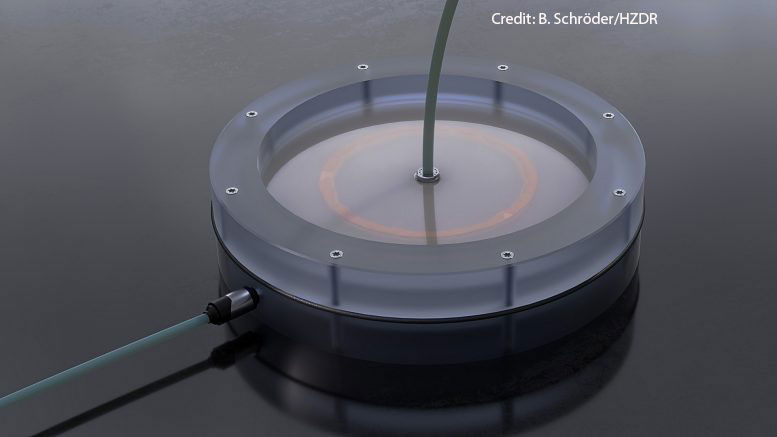Unleashing the Cosmos: Discover the Mind-Blowing Secrets of Zero Gravity Diffusion!
zero gravity diffusion experiments
Zero-Gravity Experiments Isolate Diffusion in Chemical Reactors: New Insights from Microgravity Studies
Experiments in zero-gravity conditions isolate the fundamental phenomenon of diffusion.
For many years, researchers have developed a variety of models to elucidate a critical class of mixing effects, such as those observed in the flow dynamics within chemical reactors.
However, the empirical validation of these models has lagged considerably, primarily due to the distorting influence of gravity.
A European research consortium, which includes the Helmholtz-Zentrum Dresden-Rossendorf (HZDR) and collaborators from the University of Szeged (Hungary) and Université libre de Bruxelles (ULB, Belgium), has bridged this gap through experiments conducted in a weightless environment. The team recently published their findings in the journal npj Microgravity.
Reaction-diffusion fronts, which occur when two chemicals react and simultaneously spread out, serve as a model for understanding complex problems in chemistry and physics.
This effect is also applicable to diverse fields such as finance and linguistics, as the underlying mathematical equations share similar characteristics.
The complexity of these phenomena increases when researchers introduce fluid flows into the reactions.
Such processes are crucial for technological applications, including combustion, geology, material production, and carbon dioxide storage. Despite the wide range of applications, essential aspects of these systems remain incompletely understood.
“Previous experiments aimed at validating models of these processes have been skewed by buoyancy effects caused by density differences in the reaction solutions,” explains Dr. Karin Schwarzenberger from HZDR’s Institute of Fluid Dynamics. “To isolate this issue, we conducted experiments under weightlessness aboard a sounding rocket. Our collaborators also performed parallel numerical simulations to highlight the significance of two-dimensional effects, which are not accounted for in simple one-dimensional models.”
zero gravity diffusion experiments: Rocket launch at the Arctic Circle
The experiment took place on October 1, 2022, aboard the sounding rocket TEXUS-57, launched from the Esrange Space Center, located 40 kilometers east of Kiruna, Sweden.
The project, a collaboration with Airbus Defense & Space, the European Space Agency (ESA), and the German Aerospace Center (DLR), carried the Schwarzenberger team’s experimental module to the brink of space.
The module contained three reactors of varying sizes, each consisting of stacked glass plates positioned at different intervals. The rocket ascended to 240 kilometers, achieving near-complete weightlessness for almost six minutes.
During this brief period, the researchers conducted their experiments automatically, the result of meticulous planning over several years.
The reaction was triggered as soon as weightlessness was attained. Three high-resolution cameras captured the reaction fronts that developed between two flowing liquids.
These images were the focal point of the team’s efforts, enabling them to isolate a specific mixing effect from other fluid dynamics phenomena.
zero gravity diffusion experiments: Fluid dynamics in zero gravity
In liquid channels, flow patterns exhibit uneven velocity distributions due to friction with the channel walls, which in turn affects the transport of dissolved substances and diffusing reactants.
This diffusion effect, known as Taylor-Aris dispersion, was first understood through the work of two pioneering researchers in the 1950s.
Theoretical studies have since proposed models of varying complexity to describe the interplay between Taylor-Aris dispersion and chemical reactions.
In practical applications, it is crucial to determine the conditions under which these models are valid. This necessitated conducting experiments to isolate Taylor-Aris dispersion from other fluid dynamics phenomena.
On Earth, Taylor-Aris dispersion is heavily influenced by buoyancy effects due to gravity. Until now, researchers attempted to minimize these effects by using shallow reactors, but they could never completely eliminate them because a specific range of reactor heights and flow velocities still needed to be tested to cover many application fields.
However, the larger the flow system, the more pronounced the gravitational influence. The researchers have now overcome these constraints by performing experiments in a zero-gravity environment.
A comparison with reference experiments conducted on Earth revealed significantly less reaction product formation in larger reactors under weightlessness.
More importantly, the image data of the reaction fronts were not distorted by buoyancy effects, allowing the Brussels team to replicate the development of the front in various theoretical models.
The joint evaluation demonstrated that in very shallow reactors with slow flow, simple one-dimensional models are adequate. However, in larger reactors or with faster flow, two-dimensional models incorporating Taylor-Aris dispersion are necessary.
These validated correlations can now be employed to predict product formation, which can inform the design of innovative reactors for targeted particle synthesis, fluid transport in geological layers, and even the resupply of space stations, where gravitational conditions differ significantly from those on Earth.
Reference
“Unraveling dispersion and buoyancy dynamics around radial A + B → C reaction fronts: microgravity experiments and numerical simulations” by Yorgos Stergiou, Darío M. Escala, Paszkál Papp, Dezső Horváth, Marcus J. B. Hauser, Fabian Brau, Anne De Wit, Ágota Tóth, Kerstin Eckert, and Karin Schwarzenberger, 9 May 2024, npj Microgravity.







